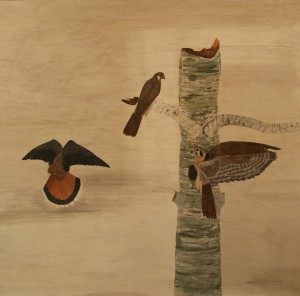http://en.wikipedia.org/wiki/Kestrel
Scientific Name: Falco sparverius Wingspan/Size: 22”/12”
How to identify them:
The coloring is mostly reddish brown, ashy blue, black and white. The female is duller than the male. Crown spot, back and tail reddish brown; back is spotted with dark. Tail edge banded with dark and edged with white; wings are blue grey. Under parts white, legs yellow. Two “whiskers” one each side of face.
Where to find them in Oregon:
Common in or around Sauvie Island, Finley Wildlife Refuge, Fern Ridge, Rogue Valley, Santiam Pall, Wallowa County, Klamath Marsh. Uncommon in rest of state.
Preferred Habitat:
Open or semi-open country
General Behavior:
The smallest and most common falcon in North America. Eats primarily insects such as grasshoppers and beetles as well as small rodents, all of which can harm crops. It frequently hovers, watching for prey, then swoops down and grabs it.
Call:
killy killy killy in a sharp tone.
Nesting Behavior:
Will nest in tree holes, rock crevices or small openings in buildings, even large bird houses. Laying four to five buff or reddish-white eggs with spots of brown. Both male and female share incubation.
Citations:
Robbins, Chandler S.; Bruun, Bertell; Zim, Herbert S.; A Guide to Field Identification Birds of North America, New York, Golden Press: 1966, pp 78 & 79
Ramsey, Fred L. Birding Oregon, Corvallis: Audubon Society of Corvallis, 1978, p 160
Baron, Nancy; Acorn, John, Birds of the Pacific Northwest Coast, Renton, Washington, Lone Pine Publishing 1997, p 130
Falcon and Falconry, World Book Encyclopedia, World Book, Inc., Chicago, 1985, Volume 7 ‘F’, p 12
Falcon and Falconry, World Book Encyclopedia, World Book, Inc., Chicago, 1985, Volume 11 ‘J-K’, p 237

